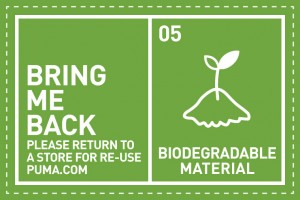Cradle to Cradle certified products
In 2013 Puma launched two new collections called “incycle”. Puma Incycle is the Industries first cradle to cradle certified selection of recyclable and biodegradable clothes, acesorries, and shoes. They have implemented a technical and a biological process to create their first 100% closed loop and cradle to cradle certified product line specifically footwear, apparel and accessories. This collection is very efficient and sustainable because it takes into account the whole life cycle and the supply chain of the product. The incycle range is broken down as in the figure below for PUMA suede sneakers and T7 track jackets.
The biological cycle starts with industrial composting to decompose the product, and turn it into biological nutrients. These nutrients then can be used to help grow resources such as cotton to make new products. The technical cycle shreds the product into raw materials by a machine that is specifically designed to break down clothes. Then those materials are melted down to make polyester pellets, which are then used in the production of other products.
https://www.youtube.com/watch?v=j9zfkYHtuMc
Puma implemented “Bring Me Back” program in order to prevent people from tossing the products in the garbage and put them back into the production cycle. They have placed bins into their store to make it more convenient, and increase the customer participation for this initiative.
This is not the first step Puma has taken to reduce their environmental “paw” print, and it sure will not be the last. We as consumers are expecting the brand to take stronger initiatives and make the clothing industry greener.
References:
http://www.sustainablebrands.com/sites/default/files/A4_Cycles_PREVIEW_sm.jpg
http://www.apinatbio.com/eng/apinat-puma.html
http://www.gizmag.com/puma-incycle-recyclable-biodegradable/26273/
http://www.c2ccertified.org/innovation-stories/puma



Hi Burak,
Interesting post – I had no idea this Puma Incycle clothing line existed. As per usual, I was a little skeptical of the company’s claims, as it seems like a marketing ploy. For one thing, it is a very small line within their overall offerings and doesn’t make the impact that converting their whole business would, so it seems like something they did just to talk about. As well, the processes that biodegrade or break down the clothing could potentially be energy exhaustive.
But I found an interesting valuation of the “True Cost” of Puma’s Incycle shoe versus their normal shoe here: http://www.trucost.com/_uploads/downloads/GreenBiz_true%20cost%20of%20clothing.pdf
It breaks down the costs in terms of Greenhouse Gases, air, water, waste and land use showing that the ‘true cost’ really is lower for the Incycle shoe.
Hi Burak,
As someone who works in retail clothing, it was definitely very exciting to read about Puma’s InCycle collection. I hope the collection sells well and encourages other apparel companies to do the same. Something I also wanted to point out was the business ingenuity Puma came up with by incorporating the “bring back bin”. Traffic is obviously a huge driver of sales, so I believe that encouraging consumers to return to the store to recycle their InCycle clothes will directly increase the profitability of its stores.
One thing that does concern me though is the fact that Puma is using organic materials in their InCycle collection. From my other readings and coursework, it appears that natural fibres eventually break down to the point where you can no longer make useful products out of it. I would have thought that 100% closed loop clothing utilized synthetic fibres instead.
http://www.theguardian.com/sustainable-business/sustainable-fashion-blog/2015/jan/22/fabric-recycling-closed-loop-process-high-street-fashion
Hi Burak,
This is awesome! I had no idea Puma was this sustainable, but it makes sense when you look at how the sports apparel industry has shifted over the past decade.
My question is, where can Puma go from here? As you’ve pointed out, the process is now cradle to cradle, which would make me think that more sustainable initiatives would be tied around process. If this is the case, I would love to hear about potential partnerships. I did some research into the partnership between Nike and DyeCoo, which benefits both partners and adds legitimacy to Nike’s operations. Is there something like this where Puma can limit the amount of water used in processes, or produce less waste overall? Additionally, would you think they would buy a company to do this or create long-term relationships that are mutually beneficial for both firms?
Thanks!
– Sam D
Hey Burak!
When we discussed this in class I was super impressed, I never expected companies to be able to find a feasible method to ‘recycle’ their clothing in a mass, industrial manner. I feel like more and more clothing companies especially are becoming aware of the amount of waste they are responsible for and taking action. Based on some information I retained from this short video about ‘the story of stuff’ https://www.youtube.com/watch?v=9GorqroigqM , I was made aware that in the United States, consumers typically only keep 1% of the ‘stuff’ they purchased six months ago. I’m guessing clothes are probably a huge portion of that too. So it’s pretty significant that clothing companies are looking into methods to make it more convenient for consumer to recycle and more feasible for their business to deal with all this waste people are producing.
Now moving forward, although Puma is doing all these great things, I feel like they haven’t done a great job promoting these breakthroughs. Personally, the first time I heard of their InCycle collection was in class, even though they launched it long before then. Do you think they would attract a more diverse range of consumers to help them boost their brand awareness amongst active, health conscious environmentalists if they pushed their InCycle product harder? Or is it better as a grass roots kind of advertising where they wait for consumers to find them on their own? I feel like this is a great example of how a company could leverage their environmental innovations to market itself, and sit on the ‘good business’ portion of the business model.
Thanks!
Sarah Paw
Hi Burak!
Interesting article about Puma’s biodegradable collection! There are so many things that are brought up in class and through these blogs that I’ve never heard of before. The idea of having bins at their stores reminds me of how Patagonia takes back worn items and they recycle or repurpose it for you. I have to agree with Sarah’s comment that their promotions for their new collection is not very known. I think in order for this idea to work not only does their marketing campaigns have to be effective, but they also have to ensure that all their employees and sales force are knowledgeable and can teach the customers. Or else, the consumers will end up just buying it and throwing them out like any other old shoe they have.
Cheers!
Katie
Hi Burak!
Interesting post! I really want to see how this program develops within the next few years. This is another great cradle-to-cradle program implemented by a multinational corporation. However, like others mentioned before, I am concerned that this is simply encouraging people to be consumers of sustainability rather than actual sustainable consumers. Will this encourage people to simply buy their way out of the problem? Is Puma also taking other steps to minimize the ENTIRE manufacturing process or is this program using more resources in an unsustainable manner? I know we all sound very critical at this point in time but if we don’t start with anything, the ball will never get rolling. Good job Puma!
– J.Lin